International Steel Prices
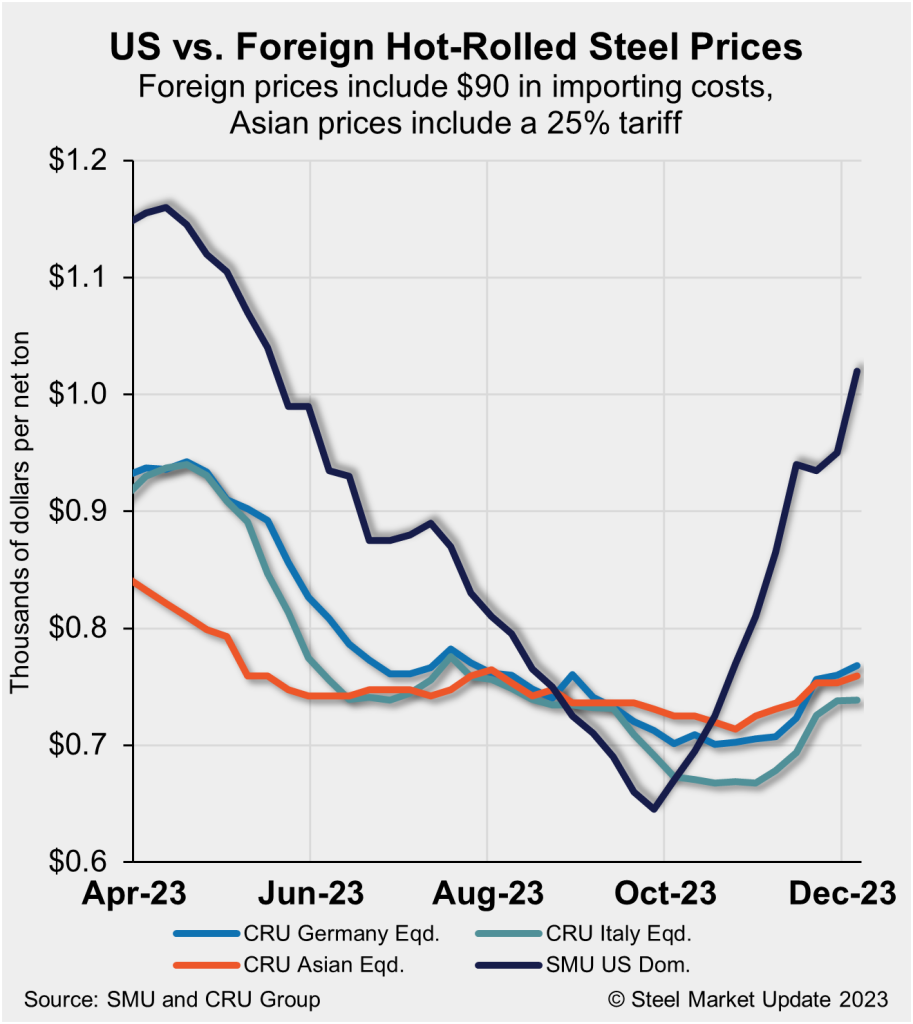
US HRC now $270/ton more expensive than imports
Written by David Schollaert
December 7, 2023
US Hot-rolled coil (HRC) prices keep rising on the heels of continued mill hikes, outpacing increases for offshore product. Domestic tags are now 26% more expensive than imports, the widest pricing gap since January 2022.
Domestic HRC tags have increased for the 10th consecutive week. While imports have been on a five-week rally, the gains have been a fraction of the increases seen in the US, according to SMU’s latest foreign vs. domestic price analysis.
Cliffs is also now targeting $1,100 per ton ($55 per cwt) base prices for HRC, according to a notice on Dec. 6, matching Nucor’s Nov. 27 notice. US HRC tags increased to $1,020 per ton on average based on SMU’s latest check of the market on Tuesday, Dec. 5. That’s a jump of $70 per ton from the week before and a surge of $375 per ton from their lowest point of the year, $645 per ton in late September.
Import prices, in contrast, had been largely trending downward since late April, increasing only over the past five weeks. The result: Imported product is now 26% cheaper than domestic material once freight and other costs are accounted for. That’s up from 21% a week earlier and a shift from late September, when imports were nearly 11% more expensive than US product.
Methodology
This is how SMU calculates the theoretical spread between domestic HRC prices (FOB domestic mills) and foreign HRC prices (delivered to US ports): We compare SMU’s US HRC weekly index to the CRU HRC weekly indices for Germany, Italy, and East and Southeast Asian ports. This is only a theoretical calculation. Import costs can vary greatly, influencing the true market spread.
We add $90 per ton to all foreign prices as a rough means of accounting for freight costs, handling, and trader margin. This gives us an approximate CIF US ports price to compare to the SMU domestic HRC price. Buyers should use our $90-per-ton figure as a benchmark and adjust up or down based on their own shipping and handling costs. If you import steel and want to share your thoughts on these costs, please don’t hesitate to get in touch with david@steelmarketupdate.com.
Asian hot-rolled coil (East and Southeast Asian ports)
As of Thursday, Dec. 7, the CRU Asian HRC price was $535 per ton, up just $4 per ton from the previous week. Adding a 25% tariff and $90 per ton in estimated import costs, the delivered price of Asian HRC to the US is approximately $759 per ton. The latest SMU hot rolled average for domestic material is $1,020 per ton.
The result: US-produced HRC is theoretically $261 per ton more expensive than steel imported from Asia, a seven-month high.
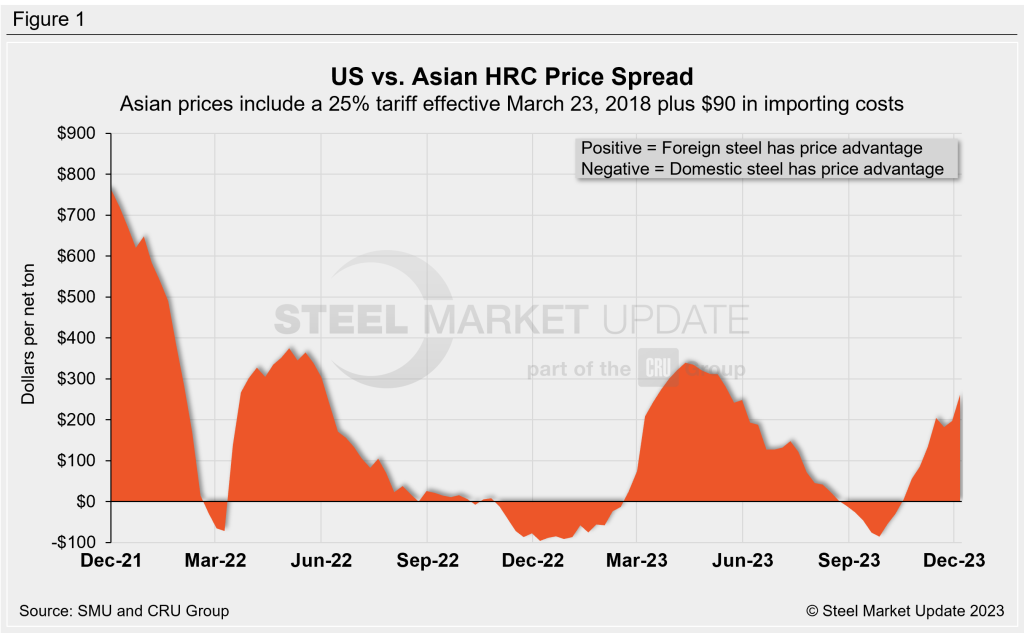
Italian hot-rolled coil
Italian HRC prices were largely sideways vs. last week, up just $1 per ton to roughly $649 per ton, and are now up just $71 per ton over the past month vs. a $150-per-ton surge in the US. After adding import costs, the delivered price of Italian HRC is in theory $739 per ton.
That means domestic HRC is theoretically $281 per ton more expensive than HRC imported from Italy. US prices haven’t been that expensive since early Feb. 2022. The current price gap is also a $330-per-ton swing from late September when US prices were $49 per ton cheaper than prices for Italian hot band.
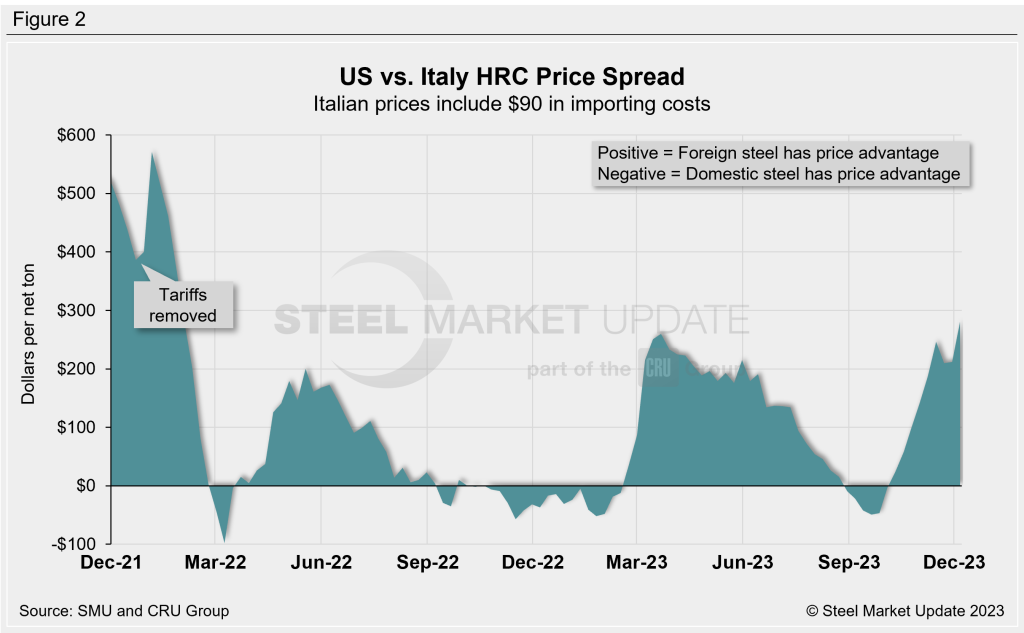
German hot-rolled coil
CRU’s German HRC prices increased by just $8 per ton week over week (WoW) to $678 per ton. After adding import costs, the delivered price of German HRC is in theory $768 per ton. The result: Domestic HRC is theoretically $252 per ton more expensive than HRC imported from Germany, a $62-per-ton jump WoW.
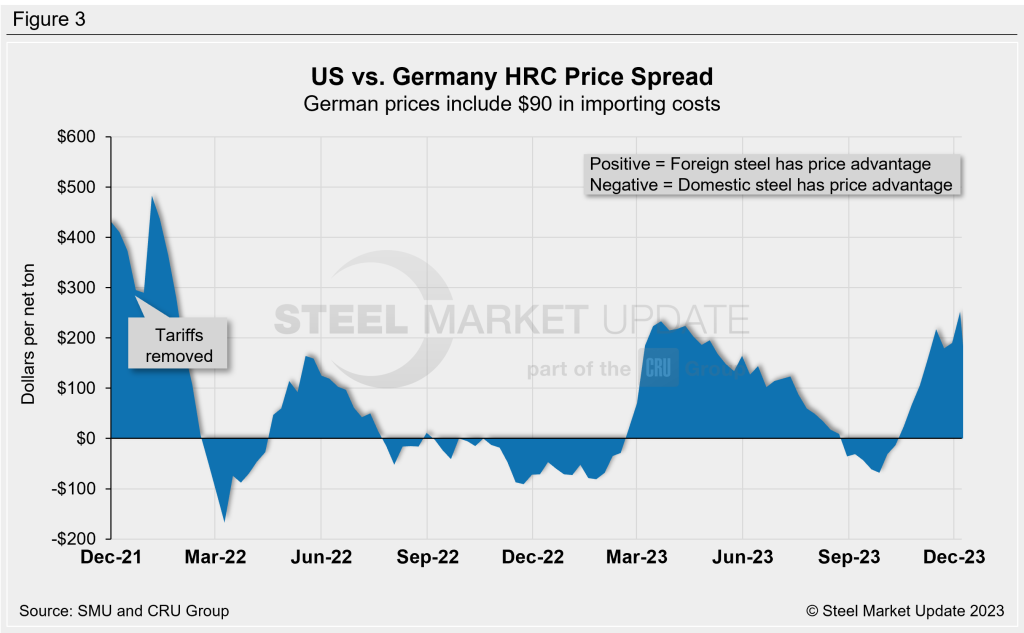
Figure 4 compares all four price indices. The chart on the right zooms in to highlight the difference in pricing from the second quarter of this year to the present.
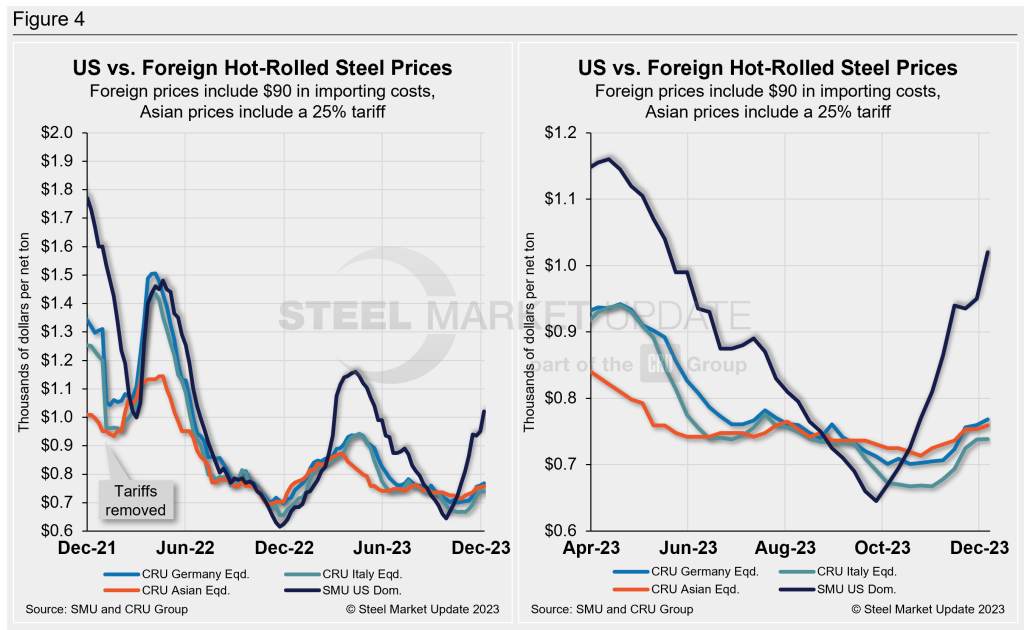
Notes: Freight is important in deciding whether to import foreign steel or buy from a domestic mill. Domestic prices are referenced as FOB the producing mill, while foreign prices are CIF the port (Houston, NOLA, Savannah, Los Angeles, Camden, etc.). Inland freight, from either a domestic mill or from the port, can dramatically impact the competitiveness of both domestic and foreign steel. It’s also important to factor in lead times. In most markets, domestic steel will deliver more quickly than foreign steel.
Effective Jan. 1, 2022, the traditional Section 232 tariff no longer applies to most imports from the European Union. It has been replaced by a tariff rate quota (TRQ). Therefore, the German and Italian price comparisons in this analysis no longer include a 25% tariff. SMU still includes the 25% Section 232 tariff on foreign prices from other countries. We do not include any antidumping (AD) or countervailing duties (CVD) in this analysis.

David Schollaert
Read more from David SchollaertLatest in International Steel Prices

US and offshore HRC prices tick lower
The threat of tariffs over the past two months has been a springboard for US prices. But the Section 232 reinstatement on March 13 narrowed the domestic premium over imports on a landed basis.

Domestic CRC prices surge ahead of imports
The price spread between stateside-produced CR and imports reached its widest margin in over a year.

US HR prices rising faster than offshore tags
Hot-rolled (HR) coil prices continued to rally in the US this week, quickly outpacing price gains seen abroad. The result: US hot band prices have grown widely more expensive than imports on a landed basis. The premium US HR tags carry over HR prices abroad now stands at a 14-month high. SMU’s average domestic HR […]

US HR price premium over imports widens
Hot-rolled (HR) coil prices were flat in the US this week, while tags in offshore markets were mostly down.

US HR price premium over imports edges up
The price premium between stateside hot band and landed imports widened slightly this week.
